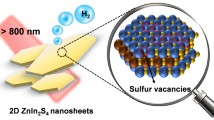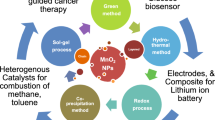Abstract
Uniform hierarchical star-like ferrous tungstate (FeWO4) is synthesized in a facile manner via a biomolecule-assisted green route without the need for using pre-fabricated templates and reductive agents. l-cysteine in this protocol was not only skillfully useful as a complexing and reducing agent, but also utilized as a structure-directing agent for the formation of star nanostructure. The as-prepared FeWO4 nanostars were characterized by X-ray powder diffraction, scanning electron microscopy, transmission electron microscopy, high-resolution transmission electron microscopy, etc. The results indicate that thickness of the star-like FeWO4 orderly assembled by the nanosheets is ~50 nm. The concentrations of l-cysteine and reaction time play important roles in the assembly of the star-like nanostructure. The morphology of FeWO4 dramatically varies from nanowires (diameter of ~20 nm) to nanoblades with an average thickness of 40 nm, then to the hierarchical star-like FeWO4 according to the changes of experiment conditions. The resulting FeWO4 nanostars with higher order symmetries were phase-pure and possess single crystalline structure. In addition, the star-like FeWO4 shows a small ferromagnetic ordering at low temperature. Moreover, a coordination adsorption and oriented attachment and Ostwald ripening mechanism are proposed for explaining the formation process of star-like FeWO4.








Similar content being viewed by others
References
Ambrose T, Chien C (1996) Finite-size effects and uncompensated magnetization in thin antiferromagnetic CoO layers. Phys Rev Lett 76(10):1743–1746
Badilescu S, Ashrit P (2003) Study of sol-gel prepared nanostructured WO3 thin films and composites for electrochromic applications. Solid State Ion 158(1–2):187–197
Cai W, Yu J, Gu S, Jaroniec M (2010) Facile hydrothermal synthesis of hierarchical boehmite: sulfate-mediated transformation from nanoflakes to hollow microspheres. Cryst Growth Des 10:3977–3982
Cantalini C, Wlodarski W, Li Y, Passacantando M, Santucci S, Comini E, Faglia G, Sberveglieri G (2000) Investigation on the O3 sensitivity properties of WO3 thin films prepared by sol-gel, thermal evaporation and rf sputtering techniques. Sens Actuators B 64(1–3):182–188
Chen A, Peng X, Koczkur K, Miller B (2004) Super-hydrophobic tin oxide nanoflowers. Chem Commun 17:1964–1965
Chen Z, Qian L, Zhu J, Yuan Y, Qian X (2010) Controlled synthesis of hierarchical Bi2WO6 microspheres with improved visible-light-driven photocatalytic activity. CrystEngComm 12(7):2100–2106
Colón G, López S, Hidalgo M, Navío J (2010) Sunlight highly photoactive Bi2WO6-TiO2 heterostructures for rhodamine B degradation. Chem Commun 46(26):4809–4811
Ejima T, Banse T, Takatsuka H, Kondo Y, Ishino M, Kimura N, Watanabe M, Matsubara I (2006) Microscopic optical and photoelectron measurements of MWO4 (M = Mn, Fe, and Ni). J Lumin 119:59–63
Hu W, Zhao Y, Liu Z, Dunnill CW, Gregory DH, Zhu Y (2008) Nanostructural evolution: from one-dimensional tungsten oxide nanowires to three-dimensional ferberite flowers. Chem Mater 20(17):5657–5665
Huang Y, Ai Z, Ho W, Chen M, Lee S (2010) Ultrasonic spray pyrolysis synthesis of porous Bi2WO6 microspheres and their visible-light-induced photocatalytic removal of NO. J Phys Chem C 114(14):6342–6349
Hupp JT, Poeppelmeier KR (2005) Better living through nanopore chemistry. Science 309(5743):2008–2009
Li WN, Yuan J, Shen XF, Gomez S, Xu L, Sithambaram S, Aindow M, Suib S (2006) Hydrothermal synthesis of structure- and shape-controlled manganese oxide octahedral molecular sieve nanomaterials. Adv Funct Mater 16(9):1247–1253
Li Y, Liu J, Huang X, Li G (2007) Hydrothermal synthesis of Bi2WO6 uniform hierarchical microspheres. Cryst Growth Des 7(7):1350–1355
Li GS, Zhang DQ, Yu JC (2009a) A new visible-light photocatalyst: CdS quantum dots embedded mesoporous TiO2. Environ Sci Technol 43(18):7079–7085
Li Y, Koshizaki N, Shimizu Y, Li L, Gao S, Sasaki T (2009b) Unconventional lithography for hierarchical micro-/nanostructure arrays with well-aligned 1D crystalline nanostructures: design and creation based on the colloidal monolayer. ACS Appl Mater Interfaces 1(11):2580–2585
Obermayer H, Dachs H, Schrocke H (1973) Investigations concerning the coexistence of two magnetic phases in mixed crystals (Fe, Mn) WO4. Solid State Commun 12(8):779–784
Shi H, Qi L, Ma J, Cheng H (2003) Polymer-directed synthesis of penniform BaWO4 nanostructures in reverse micelles. J Am Chem Soc 125(12):3450–3451
Shim HW, Cho IS, Hong KS, Cho WI, Kim DW (2010) Li electroactivity of iron (II) tungstate nanorods. Nanotechnology 2:465602–465608
Sounart TL, Liu J, Voigt JA, Hsu JWP, Spoerke ED, Tian Z, Jiang Y (2006) Sequential nucleation and growth of complex nanostructured films. Adv Funct Mater 16(3):335–344
Thongtem S, Wannapop S, Thongtem T (2009) Characterization of CoWO4 nano-particles produced using the spray pyrolysis. Ceram Int 35(5):2087–2091
Thongtem T, Pilapong C, Kavinchan J, Phuruangrat A, Thongtem S (2010) Microwave-assisted hydrothermal synthesis of Bi2S3 nanorods in flower-shaped bundles. J Alloy Compd 500(2):195–199
Tsyntsaru N, Bobanova J, Ye X, Cesiulis H, Dikusar A, Prosycevas I, Celis JP (2009) Iron-tungsten alloys electrodeposited under direct current from citrate-ammonia plating baths. Surf Coat Technol 203(20–21):3136–3141
Whang D, Jin S, Wu Y, Lieber CM (2003) Large-scale hierarchical organization of nanowire arrays for integrated nanosystems. Nano Lett 3(9):1255–1259
Wu J, Duan F, Zheng Y, Xie Y (2007) Synthesis of Bi2WO6 nanoplate-built hierarchical nest-like structures with visible-light-induced photocatalytic activity. J Phys Chem C 111(34):12866–12871
Xu L, Chen Q, Xu D (2007) Hierarchical ZnO nanostructures obtained by electrodeposition. J Phys Chem C 111(31):11560–11565
Yang P (2003) Nanotechnology: wires on water. Nature 425(6955):243–244
Yu SH, Liu B, Mo MS, Huang JH, Liu XM, Qian YT (2003) General synthesis of single-crystal tungstate nanorods/nanowires: a facile, low-temperature solution approach. Adv Funct Mater 13(8):639–647
Zhang Q, Yao WT, Chen X, Zhu L, Fu Y, Zhang G, Sheng L, Yu SH (2007) Nearly monodisperse tungstate MWO4 microspheres (M = Pb, Ca): surfactant-assisted solution synthesis and optical properties. Cryst Growth Des 7(8):1423–1431
Zhang J, Wang Y, Li SK, Wang XF, Huang FZ, Xie AJ, Shen YH (2011) Controlled synthesis, growth mechanism and optical properties of FeWO4 hierarchical microstructures. CrystEngComm 13(19):5744–5750
Zhou YX, Zhang Q, Gong JY, Yu SH (2008) Surfactant-assisted hydrothermal synthesis and magnetic properties of urchin-like MnWO4 microspheres. J Phys Chem C 112(35):13383–13389
Zhou YX, Yao HB, Zhang Q, Gong JY, Liu SJ, Yu SH (2009) Hierarchical FeWO4 microcrystals: solvothermal synthesis and their photocatalytic and magnetic properties. Inorg Chem 48(3):1082–1090
Acknowledgments
This work is supported by the National Science Foundation of China (Grants 91022032, 20871001, 50973001 and 31070730), the Important Project of Anhui Provincial Education Department (ZD2007004-1), the Science Foundation for Excellent Youth Scholars of Higher Education of Anhui Province (2011SQRL016ZD, 2009SQRZ023), 211 Project of Anhui University (2009QN012A).
Author information
Authors and Affiliations
Corresponding authors
Rights and permissions
About this article
Cite this article
Zhang, J., Zhang, Y., Yan, JY. et al. A novel synthesis of star-like FeWO4 nanocrystals via a biomolecule-assisted route. J Nanopart Res 14, 796 (2012). https://doi.org/10.1007/s11051-012-0796-6
Received:
Accepted:
Published:
DOI: https://doi.org/10.1007/s11051-012-0796-6




